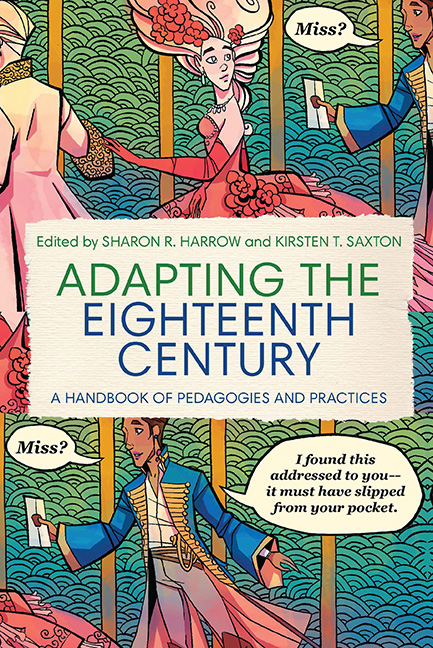Book contents
- Frontmatter
- Dedication
- Contents
- Acknowledgments
- Introduction
- 1 “Je suis Voltaire,” or, Appropriating the Philosophe in the Social Media Age
- 2 “Who Lives, Who Dies, Who Tells Your Story?”: The Uses of Hamilton in Special Collections Pedagogy and Public Engagement
- 3 Performing Frankenstein in the South: Sex, Race, and Science across the Disciplines
- 4 French Fairy Tales and Adaptations in the Twenty-First-Century Classroom
- 5 Select Trials at the Sessions-House in the Old-Bailey (1742) and Mark Ravenhill’s Mother Clap’s Molly House (2001)
- 6 Teaching with The Pilgrim’s Progress Video Game
- 7 Eliza Haywood’s “Bad Habits”: Teaching Adaptations of Fantomina: or, Love in a Maze and The Distress’d Orphan; or, Love in a Madhouse
- 8 Teaching Eighteenth-Century Literature through Eighteenth- Century Adaptations: Adaptive Structures
- 9 “A Private Had Been Flogged”: Adaptation and the “Invisible World” of Jane Austen
- 10 Fifty Shades of Pamela in the Undergraduate Classroom
- 11 Teaching the Austen-Monster-Mashup: Sense and Sensibility and Sea Monsters
- 12 Learning to Adapt: Teaching Pride and Prejudice and Its Adaptations in General Education Courses
- 13 Race and Romance: Adapting Free Women of Color in the Long Eighteenth Century
- 14 The Crusoeiana: Material Crusoe
- 15 Adaptation in Strange Places: Terrence Malick’s To the Wonder and the Narrative Effect and Form of Samuel Richardson’s Pamela
- 16 Adapting the Tombeaux des Princes: A Study in Media Variations
- 17 Experiential Pedagogy to Join the Thread of Conversation with Paul et Virginie
- 18 “Lookin’ for a Mind at Work”: Hamilton, Adaptation, and Enlightenment Ideals for the Core Curriculum
- Notes on the Contributors
- Index
5 - Select Trials at the Sessions-House in the Old-Bailey (1742) and Mark Ravenhill’s Mother Clap’s Molly House (2001)
Published online by Cambridge University Press: 26 April 2020
- Frontmatter
- Dedication
- Contents
- Acknowledgments
- Introduction
- 1 “Je suis Voltaire,” or, Appropriating the Philosophe in the Social Media Age
- 2 “Who Lives, Who Dies, Who Tells Your Story?”: The Uses of Hamilton in Special Collections Pedagogy and Public Engagement
- 3 Performing Frankenstein in the South: Sex, Race, and Science across the Disciplines
- 4 French Fairy Tales and Adaptations in the Twenty-First-Century Classroom
- 5 Select Trials at the Sessions-House in the Old-Bailey (1742) and Mark Ravenhill’s Mother Clap’s Molly House (2001)
- 6 Teaching with The Pilgrim’s Progress Video Game
- 7 Eliza Haywood’s “Bad Habits”: Teaching Adaptations of Fantomina: or, Love in a Maze and The Distress’d Orphan; or, Love in a Madhouse
- 8 Teaching Eighteenth-Century Literature through Eighteenth- Century Adaptations: Adaptive Structures
- 9 “A Private Had Been Flogged”: Adaptation and the “Invisible World” of Jane Austen
- 10 Fifty Shades of Pamela in the Undergraduate Classroom
- 11 Teaching the Austen-Monster-Mashup: Sense and Sensibility and Sea Monsters
- 12 Learning to Adapt: Teaching Pride and Prejudice and Its Adaptations in General Education Courses
- 13 Race and Romance: Adapting Free Women of Color in the Long Eighteenth Century
- 14 The Crusoeiana: Material Crusoe
- 15 Adaptation in Strange Places: Terrence Malick’s To the Wonder and the Narrative Effect and Form of Samuel Richardson’s Pamela
- 16 Adapting the Tombeaux des Princes: A Study in Media Variations
- 17 Experiential Pedagogy to Join the Thread of Conversation with Paul et Virginie
- 18 “Lookin’ for a Mind at Work”: Hamilton, Adaptation, and Enlightenment Ideals for the Core Curriculum
- Notes on the Contributors
- Index
Summary
ThischaptertakesupmyuseofadaptationinmyGayandLesbian LiteraturesurveycoursethatrangesfromAncientGreekandRoman poems to twenty-first-century texts. Rather than reaching definite conclu- sions about sexuality and its history, the class encourages students to rec- ognize ways that the past informs the present, and to think critically about the social contexts of power, knowledge, and history. This chapter outlines my pairing of an eighteenth-century historical legal archive of sodomy tri- als, from the Select Trials at the Sessions-House in the Old-Bailey, with a con- temporary play, Mother Clap's Molly House (2001), by Mark Ravenhill. The sodomy trials are a document whose purpose was surveillance and punish- ment of sexual practices, written and distributed by the state/church; they provide evidence of a gay culture as they attempt to decry it. The play uses the trials and other historical material to engage both the punitive histori- cal record and the social and political debates of the 1990s and 2000s. This adaptive pairing would work in any course that has an interest in histori- cizing sexuality, sexual identity, and even individual identity more gener- ally. The chapter narrates key points from my teaching experience as the class moved through the eighteenth-century material to Ravenhill's play and our contemporary moment.
Specifically, we work with the preface to Select Trials and the brief “true crime” entries/narratives for Gabriel Lawrence, William Griffin, George Kedger,ThomasWright,GeorgeWhitle,MartinMackintosh,Patrick Malcolm, William Brown, Thomas Rodin, Charles Banner, John Dicks, and Margaret Clap “for keeping a Sodomitical House” or molly house.1 Published in four volumes in 1742 and covering crimes tried between 1720 and 1741, the Select Trials volumes are available via Eighteenth Century Collections Online, Google Books, and a Garland Publishing 1985 reprint in two volumes, edited by Randolph Trumbach. Students first encounter the entries from the Select Trials in the opening weeks of the class (the selected entries record trials from the 1720s), where they are situated alongside more confessional homosexual narratives or case studies from the late nineteenth century that suggest links between criminalization and medicalization, two early modes for imagining the molly/homosexual as a person, but a person in need of correction.
- Type
- Chapter
- Information
- Adapting the Eighteenth CenturyA Handbook of Pedagogies and Practices, pp. 85 - 94Publisher: Boydell & BrewerPrint publication year: 2020

